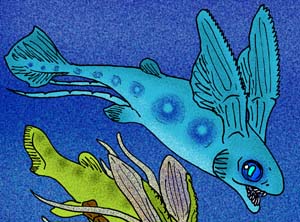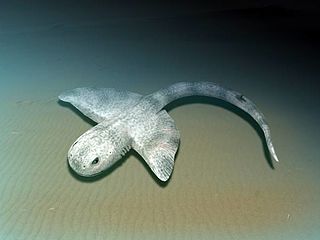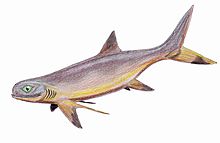
Chondrichthyes is a class of jawed fish that contains the cartilaginous fish or chondrichthyans, which all have skeletons primarily composed of cartilage. They can be contrasted with the Osteichthyes or bony fish, which have skeletons primarily composed of bone tissue. Chondrichthyes are aquatic vertebrates with paired fins, paired nares, placoid scales, conus arteriosus in the heart, and a lack of opercula and swim bladders. Within the infraphylum Gnathostomata, cartilaginous fishes are distinct from all other jawed vertebrates.

Elasmobranchii is a subclass of Chondrichthyes or cartilaginous fish, including modern sharks, rays, skates, and sawfish. Members of this subclass are characterised by having five to seven pairs of gill clefts opening individually to the exterior, rigid dorsal fins and small placoid scales on the skin. The teeth are in several series; the upper jaw is not fused to the cranium, and the lower jaw is articulated with the upper. The details of this jaw anatomy vary between species, and help distinguish the different elasmobranch clades. The pelvic fins in males are modified to create claspers for the transfer of sperm. There is no swim bladder; instead, these fish maintain buoyancy with large livers rich in oil.

Holocephali, sometimes given the term Euchondrocephali, is a subclass of cartilaginous fish in the class Chondrichthyes. The earliest fossils are of teeth and come from the Devonian period. Little is known about these primitive forms, and the only surviving group in the subclass is the order Chimaeriformes.

Cladoselache is an extinct genus of shark-like chondrichthyan from the Late Devonian (Famennian) of North America. It was similar in body shape to modern lamnid sharks, but was not closely related to lamnids or to any other modern (selachian) shark. As an early chondrichthyan, it had yet to evolve traits of modern sharks such as accelerated tooth replacement, a loose jaw suspension, enameloid teeth, and possibly claspers.

Orthacanthus is an extinct genus of fresh-water xenacanthiform cartilaginous fish, named by Louis Agassiz in 1843, ranging from the Upper Carboniferous into the Lower Permian. Orthacanthus had a nektobenthic life habitat, with a carnivorous diet. Multiple authors have also discovered evidence of cannibalism in the diet of Orthacanthus and of "filial cannibalism" where adult Orthacanthus preyed upon juvenile Orthacanthus. Synonyms of the genus Orthacanthus are Dittodus Owen, 1867, Didymodus Cope, 1883, Diplodus Agassiz, 1843, Chilodus Giebel, 1848.

Stethacanthus is an extinct genus of shark-like cartilaginous fish which lived from the Late Devonian to Late Carboniferous epoch, dying out around 298.9 million years ago. Fossils have been found in Australia, Asia, Europe and North America.

Xenacanthida is an order or superorder of extinct shark-like chondrichthyans known from the Carboniferous to Triassic. They were native to freshwater, marginal marine and shallow marine habitats. Some xenacanths may have grown to lengths of 5 m (16 ft). Most xenacanths died out at the end of the Permian in the End-Permian Mass Extinction, with only a few forms surviving into the Triassic.

Symmoriiformes is an extinct order of stem-group holocephalians. Originally named Symmoriida by Zangerl (1981), it has subsequently been known by several other names. Lund (1986) synonymized the group with Cladodontida, while Maisey (2008) corrected the name to Symmoriiformes in order to prevent it from being mistaken for a family. The symmoriiform fossils record begins during the late Devonian. Most of them died out at the start of the Permian, but Dwykaselachus is known from the Artinskian-Kungurian of South Africa. Teeth described from the Valanginian of France and Austria indicate that members of the family Falcatidae might have survived until the Early Cretaceous; however, these teeth were also argued to be more likely neoselachian teeth.

Stethacanthidae is an extinct family of prehistoric holocephalians. It is estimated to have existed approximately between 380 and 300 million years ago. Members of this family are noted for their peculiar dorsal fin.

Falcatidae is a family of Paleozoic cartilaginous fish belonging to the order Symmoriiformes. Members of this family include Falcatus, a small fish from the Bear Gulch Limestone of Montana. The family first appeared around the start of the Carboniferous, and there is some evidence that they survived well into the early Cretaceous, though its putative Cretaceous members were also argued to be more likely neoselachians.

Hybodontiformes, commonly called hybodonts, are an extinct group of shark-like cartilaginous fish (chondrichthyans) which existed from the late Devonian to the Late Cretaceous. Hybodonts share a close common ancestry with modern sharks and rays (Neoselachii) as part of the clade Euselachii. They are distinguished from other chondrichthyans by their distinctive fin spines and cephalic spines present on the heads of males. An ecologically diverse group, they were abundant in marine and freshwater environments during the late Paleozoic and early Mesozoic, but were rare in open marine environments by the end of the Jurassic, having been largely replaced by modern sharks, though they were still common in freshwater and marginal marine habitats. They survived until the end of the Cretaceous, before going extinct.

The Eugeneodontida, sometimes also called Eugeneodontiformes, is an extinct and poorly known order of cartilaginous fishes. They possessed "tooth-whorls" on the symphysis of either the lower or both jaws and pectoral fins supported by long radials. They probably lacked pelvic fins and anal fins. The palatoquadrate was either fused to the skull or reduced. Now determined to be within the Holocephali, their closest living relatives are ratfish. The eugeneodonts are named after paleontologist Eugene S. Richardson, Jr. The Eugeneodontida disappeared in the Early Triassic. The geologically youngest fossils of the group are known from the Sulphur Mountain Formation, Vardebukta Formation and Wordie Creek Formation (Greenland).

Iniopterygiformes is an extinct order of chimaera-like cartilaginous fish that lived from the Devonian to Carboniferous periods. Fossils of them have been found in Montana, Indiana, Illinois, and Nebraska. The Iniopterygians are characterized by large pectoral fins, wing-like projections on their backs, mounted high on the body and denticulated bony plates on the head and jaws. Iniopterygian sharks were small, and their average length was about 18 inches (46 cm). The elongated pectoral fins had denticles along the leading edge which may have had a role in mating. They are thought to have been able to move their pectorals in a vertical plane, ”flying” through the water much like modern-day flying fish.
Dwykaselachus is an extinct genus of symmoriiform, a cartilaginous fish that lived in what is now South Africa during the Permian period around 280 million years ago. It was first discovered in the 1980s, in a nodule of sediments from the Karoo Supergroup. Dwykaselachus was named based on Dwyka Group, the group of sedimentary geological formation in the southeastern part of Africa. It represents the place where the type species Dwykaselachus oosthuizeni was found.

Cladodoides is a genus of extinct cartilaginous fish. It appeared in the Frasnian age of the late Devonian and possibly existed in the Tournaisian age of the early Carboniferous.
Amelacanthus is an extinct genus of elasmobranchian cartilaginous fish from the Paleozoic era. It is known from fin spines and currently contains four described species. It is known from the Permian and Carboniferous of North America, Europe, and Africa. It is also known from the Famennian of Russia. Possible specimens of Amelacanthus were found in Permian (Wordian) sediments of Oman.

Ctenacanthiformes is an extinct order of cartilaginous fish. They possessed ornamented fin spines at the front of their dorsal fins and cladodont-type dentition, that is typically of a grasping morphology, though some taxa developed cutting and gouging tooth morphologies. Some ctenacanths are thought to have reached sizes comparable to the great white shark, with body lengths of up to 7 metres (23 ft) and weights of 1,500–2,500 kilograms (3,300–5,500 lb). The earliest ctenacanths appeared during the Frasnian stage of the Late Devonian, with the group reaching their greatest diversity during the Early Carboniferous (Mississippian), and continued to exist into at least the Middle Permian (Guadalupian). Some authors have suggested members of the family Ctenacanthidae may have survived into the Cretaceous based on teeth found in deep water deposits of Valanginian age in France and Austria, however, other authors contend that the similarity of these teeth to Paleozoic ctenacanths is only superficial, and they likely belong to neoselachians instead.

Cretacladoides is a genus of chondrichthyan, possibly a falcatid, found in France and Austria. Known solely from teeth, mainly found in the Klausrieglerbach locality of Austria, it consists of two species, C. ogiveformis and C. noricum. Assuming a falcatid identity, it is the most recent member of the family, which otherwise became extinct at the end of the Carboniferous.

Squatinactis is a genus of extinct elasmobranch chondrichthyan known from the Carboniferous aged Bear Gulch Limestone in Montana. This fish was discovered in 1974 by Richard Lund. The type specimen, named CMNH 46133, consists of a brain case, poorly preserved jaws and gills, a pectoral fin, and a partial vertebral axis. This creatures most startling feature were its broad pectoral fins which resembled those of stingrays and angel sharks (Squatina). The holotype specimen has about 15 teeth in its jaw. This creature is named after the angel shark. Remains found in the South Urals of Russia and the Eyam Limestone of Derbyshire, England, have been tentatively identified as those belonging to S. caudispinatus.

























